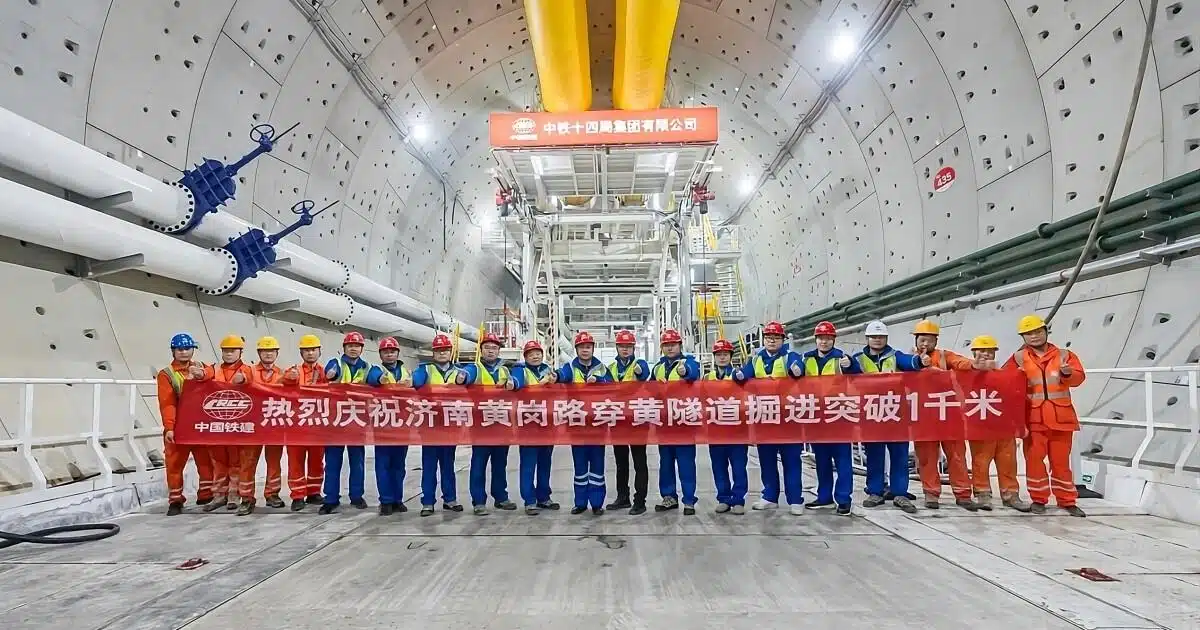
In China, the city of Jinan has achieved a monumental feat by completing the world’s largest underwater tunnel, redefining the standards of modern engineering.
China, with its passion for monumental infrastructure projects, has just added another remarkable achievement to its record: the construction of the world’s largest underwater tunnel. This colossal project, located in Jinan, the capital of Shandong province, represents not only a major technological advancement but also a symbol of the dynamism and ambition of Chinese engineering. The tunnel, with its underwater section measuring 2 miles (3,290 meters), is a masterpiece of modern design and determination. By using the largest available tunnel boring machine, engineers have succeeded in creating a structure with a diameter of 55.8 feet (17 meters), overcoming considerable technical challenges. This project promises to transform regional connectivity while setting new standards in civil engineering.
Technical Challenges of Underwater Construction
Building such a massive underwater tunnel is no easy task. Engineers must overcome complex technical challenges, particularly in managing the immense pressure exerted by the surrounding water. The Jinan tunnel, with its large 17-meter diameter, requires innovative solutions to withstand these natural forces. The « Shanhe » boring machine, developed by Herrenknecht, is at the heart of this success. This machine is designed to operate under pressures of up to 7.5 bars, or 7.5 times the normal atmospheric pressure at sea level. Thanks to an automatic air cushion pressure-balancing system, it can maintain the stability of the tunnel and prevent any risk of collapse or flooding.
Another major challenge is the removal of excavation debris. The tunnel is equipped with a flushing system that prevents the cutter wheel from getting blocked. Additionally, a telescopic camera is installed in the boring chamber to monitor the cutting tools and tunnel walls. This advanced technology reduces the need for hyperbaric interventions, which are not only complex but also dangerous for workers. Thus, the combination of innovative devices and proven methods has allowed teams to overcome technical obstacles and make rapid progress in construction.
A Speed Record for a Gigantic Project
The Jinan tunnel stands out not only for its colossal size but also for the speed at which it was constructed. The underwater segment was completed in just 110 days, setting a new world record for the construction of tunnels of this scale. This was made possible thanks to the exceptional performance of the boring machine, which was able to advance at a daily pace of 16 to 18 meters. This execution speed is a testament to the efficiency of the technologies employed and the expertise of the teams on the ground.
The success of this project required meticulous preparation and flawless coordination among the various stakeholders involved. Every step, from design to execution, was carefully planned to meet tight deadlines. Engineers had to ensure that each component of the tunnel, from the underwater protection rings to the ventilation systems, was perfectly integrated and functional. This rigorous management enabled the completion of such a large-scale project in record time, while ensuring safety and quality throughout the construction process.
Comparison with the Channel Tunnel
To better understand the significance of the Jinan tunnel, it is interesting to compare it with other similar structures, such as the famous Channel Tunnel. The latter, which connects the United Kingdom to France, consists of three tunnels, including two public railway tunnels with a diameter of 7.6 meters. While the Channel Tunnel is much longer, at 50.5 km, the diameter of the Jinan tunnel far exceeds that of its European counterpart.
This comparison highlights the technical achievement that the Jinan tunnel represents. Indeed, a larger diameter presents additional challenges in terms of structural stability and pressure management. However, these obstacles were overcome thanks to cutting-edge engineering and the use of advanced technologies. The Jinan tunnel thus showcases China’s ability to push the boundaries of modern engineering and compete with some of the most iconic Western achievements.
Impact on Regional Connectivity
The Jinan tunnel is not only an engineering marvel but also crucial for enhancing regional connectivity. By crossing the Yellow River, China’s second-longest river, the tunnel facilitates transportation between various regions of Jinan. It features six lanes in each direction, organized in a two-level configuration, with a speed limit of 60 km/h.
This new infrastructure plays a key role in the economic development of the region. It connects the main urban area of Jinan to a zone designated as the « starting point for the transformation of new and old kinetic energies. » By improving transportation links, the tunnel not only fosters trade and industry but also contributes to the growth of emerging sectors. With this enhanced connectivity, Jinan is well-positioned to become a pivotal hub for economic development in eastern China.
Source: hellobiz



